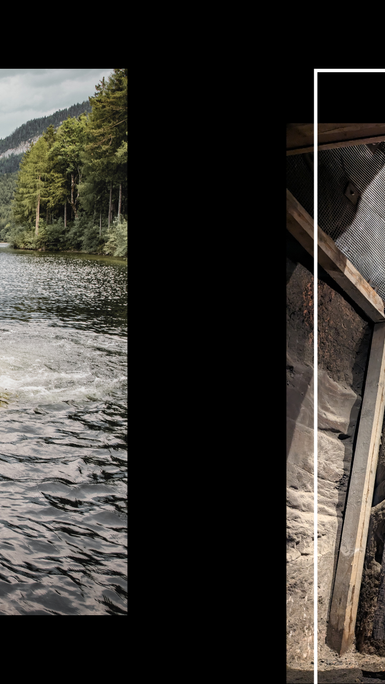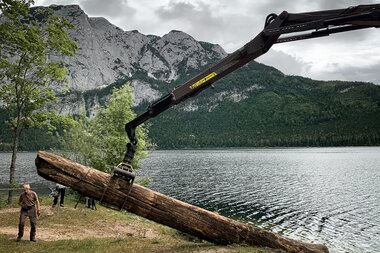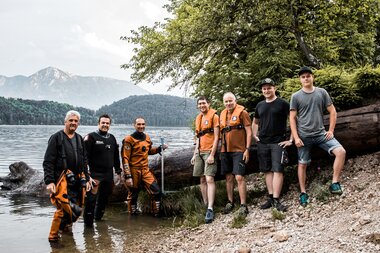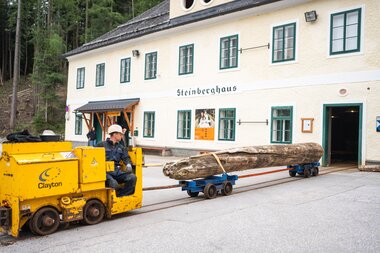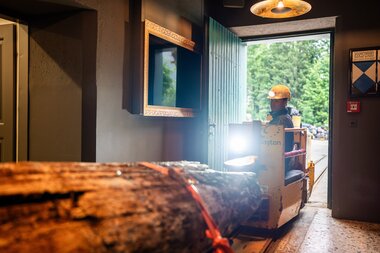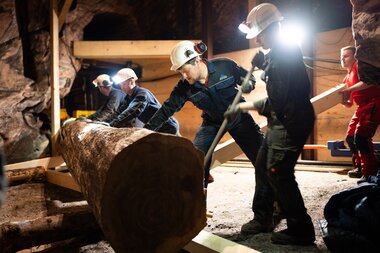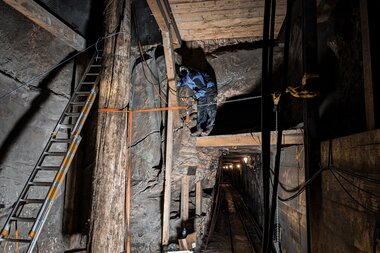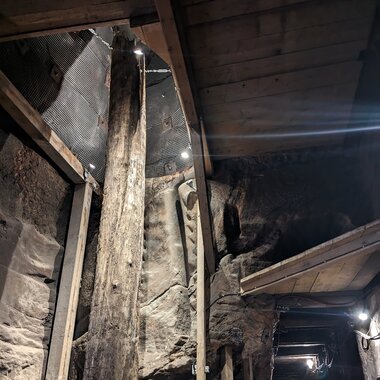How (or why) does a 1400-year-old fir tree end up inside the Altaussee salt mine?
The salty rock crunches beneath your shoes, and the walls shimmer with veins of pure rock salt. Suddenly, a large show chamber opens up before your eyes in the heart of the salt mine. During your visit to Salzwelten Altaussee, you will now also discover a massive, over one thousand-year-old fir tree from a magical underwater forest in Lake Altaussee. Why it found a new home here in the mine is what we are about to explain in this blog article. Read on to learn the fascinating backstory…
#fascination #salzwelten #altaussee #ancient tree
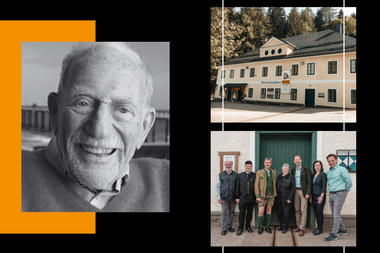
How It All Began: Salzwelten, Walter Munk & His Love for Altaussee
In order to understand why a 1400-year-old fir tree is displayed inside Salzwelten Altaussee, we need to look back a few years. On a humid summer day in 2019, an older gentleman suddenly showed up at Salzwelten in Altaussee. With an American accent, he introduced himself as Walter Munk and explained that he was the stepson of a certain Dr. Rudolf Engelsberg, the former director of the saltworks. One dedicated employee recalled a memorial plaque at the entrance to the Barbara Chapel, which mentioned that Dr. Engelsberg was present at the chapel's official opening back in 1935.
It took a bit of research to reveal who this rather modest visitor actually was: Walter Munk, the famous oceanographer who, among other things, had calculated the ocean currents in preparation for the Allied landings in Normandy! But he didn’t just visit Salzwelten; he also made connections with politicians and key decision-makers in Altaussee. Through his "Walter Munk Foundation for the Oceans," he provided (and continues to provide) significant funding for the research of Lake Altaussee in his still-beloved homeland. Sadly, Walter Munk passed away in 2019 at the ripe old age of 102.
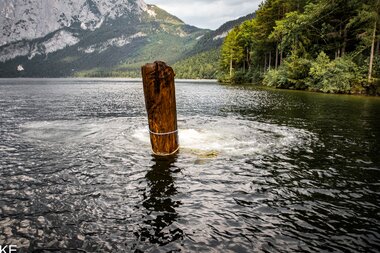
The Ancient Fir in the Magical Underwater Forest of Lake Altaussee
Ever since, prestigious institutions like the University of Natural Resources and Life Sciences Vienna, the University of Innsbruck, the Deheyn Lab in California, the HBLFA Gumpenstein-Raumberg and many others have been researching Lake Altaussee year after year.
In the course of this research, the "underwater forest" in Altaussee, which had been known of since the 1970s, was likewise investigated. This submerged forest consists of around 100 upright tree trunks ranging from one to about 15 meters in height, scattered across the entire lake.
Scientists were eager to know more. They went ahead and had one tree salvaged by the Altaussee Volunteer Fire Department. With immense effort, the divers managed to bring a six-meters-long, over two-ton trunk to the surface. The white fir they retrieved had stood upright at the "Platteneck," about 100 meters from the shore at a depth of roughly 18 meters. Researchers from BOKU Vienna established that the tree started growing around 600 AD – in the Early Middle Ages. It has 247 annual growth rings and died in 859 AD.
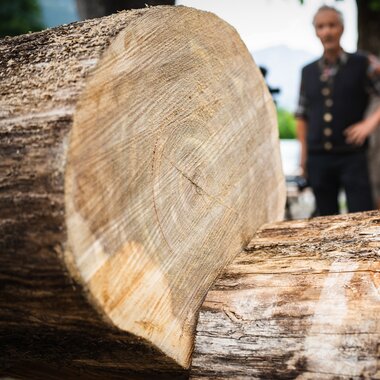
In Search of a New Home for the Fir
The question then came up: what should be done with the tree? Exposed to the elements, of course, it would eventually decay. Then, they remembered the salt mine: didn’t they store looted artworks here during World War II because of its unique preservative climate? That is where Salzwelten and Salinen Austria AG sprang into action. After extensive discussions and agreements with the Austrian Federal Forestry Service (the actual owners of the tree), practical matters needed to be considered. How do we get the huge, heavy fir into the mine? For test purposes, a full-scale model of the tree was built and brought into the salt mine. Unfortunately, the experiment showed that about one meter of the tree would have to be sawed off because it wouldn’t fit around the bends in the tunnel. But in that case, what should be done with the cut-off piece? A chance meeting at the opening of the "Augstbach Theme Trail" in Altaussee provided the answer. They decided to have that extra piece sawed into planks and donated to the renowned HTBLA in Hallstatt after drying. There, they would then be able to craft a masterpiece from the wood and auction that off for a good cause. Which is precisely what happened!
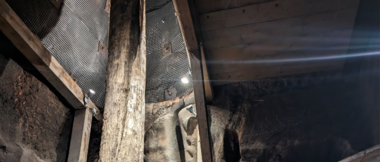
A New Highlight during the Tour of Salzwelten Altaussee
In June 2023, the relocation of the tree into the mine went smoothly. In November, the miners of Salinen Austria AG conducted blasting inside a display chamber so as to enlarge it, and the tree was finally placed there, fully upright, just as it had stood in the lake. It was, of course, illuminated appropriately and furnished with an info board. At the display site, visitors can discover highlights from the tree’s lifecycle: for example, this fir "witnessed" the birth of Charlemagne, the creation of the "Tassilo Chalice," and the plundering of Paris and Hamburg by the Vikings.
At the official unveiling in June 2024, Mary Munk, Walter Munk’s widow, attended in person and was visibly moved. She thanked everyone with a humble "Glück Auf!"
Seeing such an old tree in a mine that has existed for over 800 years makes everyone humble and allows us to sense the heritage of a long-past era even more intensely. How important it is to preserve our world with all its wonders, big as well as small, so that people will still be fascinated by them 1400 years from now!
What are your thoughts on this topic? Have you seen the fir yet? When it was rescued from Lake Altaussee, perhaps, or inside Salzwelten Altaussee itself? Share your story with us, during a visit to Salzwelten or via our social media channels – either way, we really look forward to chatting with you and hearing all the details!
Glück Auf!
Magdalena & Harald
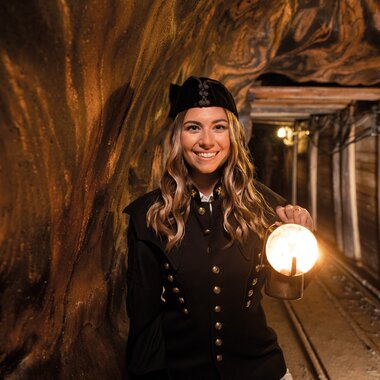
About the author
Magdalena Geistlinger
Magdalena has worked at Salzwelten since 2017. She is responsible for online marketing and social media and has a personal connection to the mine due to her own family history – her great-grandfather worked shifts deep inside the Dürrnberg mine for 40 years. Even as a child, as she played in her garden at the entrance to a magical “mine” of her own imagination, she discovered her first love for the world of salt mining…
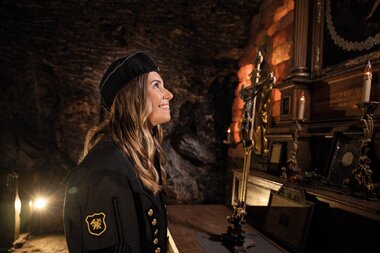
WHEN WAS YOUR LAST GOOSEBUMP MOMENT?
Join us and immerse yourself in a world that is far removed from your everyday life! Discover hidden realms full of glistening salt crystals and tunnels that seem to go on forever......
#fascination #salzwelten #bepartofit
The Fascination of Salt